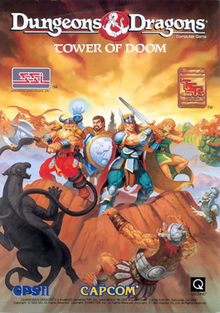
Mystara is a campaign setting for the Dungeons & Dragons fantasy role playing game. It was the default setting for the "Basic" version of the game throughout the 1980s and 1990s. Most adventures published for the "Basic" edition of D&D take place in "The Known World", a central continent that includes a varied patchwork of both human and non-human realms. The human realms are based on various real-world historical cultures. In addition, unlike other D&D settings, Mystara had ascended immortal beings instead of gods.
Hack and slash, also known as hack and slay or slash 'em up, refers to a type of gameplay that emphasizes combat with melee-based weapons. They may also feature projectile-based weapons as well as secondary weapons. It is a sub-genre of beat 'em up games, which focuses on melee combat, usually with swords. Third-person hack and slash games are also sometimes known as character action games and spectacle fighters.

X-Men vs. Street Fighter is a crossover fighting video game developed and published by Capcom. It is Capcom's third fighting game to feature Marvel Comics characters, following X-Men: Children of the Atom and Marvel Super Heroes, and is the first installment in the Marvel vs. Capcom series. As the title suggests, the game includes characters from Marvel's X-Men franchise and the cast from Capcom's Street Fighter series. Originally released as a coin-operated arcade game in 1996, it was ported to the Sega Saturn in 1997 and the PlayStation in 1998. The original arcade version is included in the game lineup for Marvel vs. Capcom Fighting Collection: Arcade Classics, released for the Nintendo Switch, PlayStation 4 and Windows in 2024.
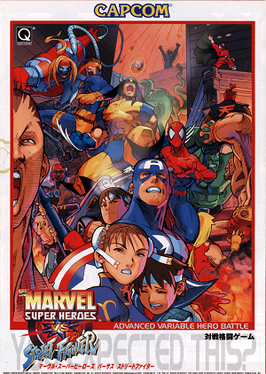
Marvel Super Heroes vs. Street Fighter is a 1997 crossover fighting video game developed and published by Capcom. It is the sequel to X-Men vs. Street Fighter (1996) and the second installment in the Marvel vs. Capcom series. After its release on arcades, it received ports to the Sega Saturn in 1998 and the PlayStation in 1999.
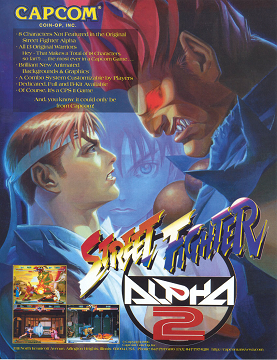
Street Fighter Alpha 2, known as Street Fighter Zero 2 in Japan, Asia, South America, and Oceania, is a 1996 fighting game originally released for the CPS II arcade hardware by Capcom. The game is a remake of the previous year's Street Fighter Alpha: Warriors' Dreams and features a number of improvements, such as new attacks, stages, endings, and gameplay features. It was ported to the PlayStation, Sega Saturn and Super Nintendo home consoles globally in 1996, and later a Windows port. It was followed by Street Fighter Alpha 3 in 1998.
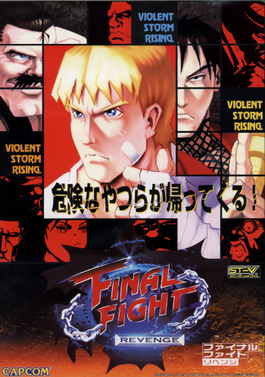
Final Fight Revenge is a 1999 3D fighting game released by Capcom, and the only one-on-one fighting game in the Final Fight series of beat 'em up games. Originally developed and released for the ST-V arcade hardware, a home version was released for the Sega Saturn in 2000 in Japan only. The cast of playable characters in Final Fight Revenge includes series mainstays Mike Haggar, Cody and Guy, along with various members of the opposing Mad Gear gang.

X-Men: Children of the Atom is a 1994 fighting game developed and published by Capcom and released on the CP System II arcade hardware. It was released in December 1994 in Japan and in January 1995 in North America and Europe.

An owlbear is a fictional creature originally created for the Dungeons & Dragons fantasy role-playing game. An owlbear is depicted as a cross between a bear and an owl, which "hugs" like a bear and attacks with its beak. Inspired by a plastic toy made in Hong Kong, Gary Gygax created the owlbear and introduced the creature to the game in the 1975 Greyhawk supplement; the creature has since appeared in every subsequent edition of the game. Owlbears, or similar beasts, also appear in several other fantasy role-playing games, video games and other media.

Marvel Super Heroes is a 1995 fighting game developed and published by Capcom. Originally released in the arcade on the CPS-2 arcade system, it was ported to the Sega Saturn and PlayStation in late 1997. The game, alongside Marvel vs. Capcom: Clash of Super Heroes, was also included in the Marvel vs. Capcom Origins collection, released digitally for the PlayStation 3 and Xbox 360 in September 2012.
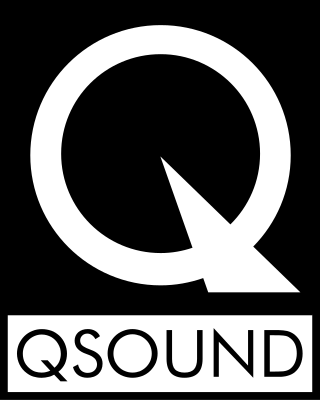
QSound is the original name for a positional three-dimensional (3D) sound processing algorithm from QSound Labs that creates 3D audio effects from multiple monophonic sources and sums the outputs to two channels for presentation over regular stereo speakers. QSound was eventually re-dubbed "Q1" after the introduction of "Q2", a positional 3D algorithm for headphones. When multi-speaker surround system support was later added to the positional 3D process, the QSound positional 3D audio process became known simply as "Q3D". QSound was founded by Larry Ryckman (CEO), Danny Lowe and John Lees. Jimmy Iovine served as senior vice president of music and Shelly Yakus as vice president of audio engineering in its formative years.

Dungeons & Dragons: Shadow over Mystara is an arcade game developed and published by Capcom in 1996 as a sequel to Dungeons & Dragons: Tower of Doom. The game is set in the Dungeons & Dragons campaign setting of Mystara.
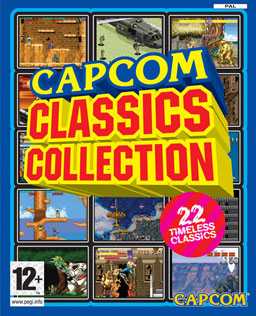
Capcom Classics Collection is a compilation of arcade games released by Capcom for the PlayStation 2 and Xbox on September 27, 2005 in North America and in 2006 in Japan. It was developed by Digital Eclipse Software, Sensory Sweep, and its Japanese developer Klein Computer Entertainment. A second volume, Capcom Classics Collection Vol. 2, was released on November 14, 2006 in North America, for PlayStation 2 and Xbox. The second volume as well as the Xbox version of the first volume were not released in Japan.
A beat 'em up is a video game genre featuring hand-to-hand combat against a large number of opponents. Traditional beat 'em ups take place in scrolling, two-dimensional (2D) levels, while a number of modern games feature more open three-dimensional (3D) environments with yet larger numbers of enemies. The gameplay tends to follow arcade genre conventions, such as being simple to learn but difficult to master, and the combat system tends to be more highly developed than other side-scrolling action games. Two-player cooperative gameplay and multiple player characters are also hallmarks of the genre. Most of these games take place in urban settings and feature crime-fighting and revenge-based plots, though some games may employ historical, science fiction or fantasy themes.
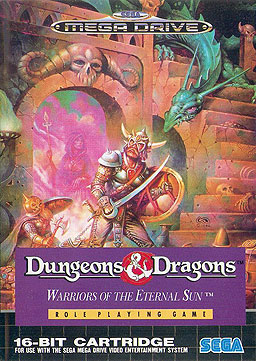
Dungeons & Dragons: Warriors of the Eternal Sun is a role-playing video game developed for the Sega Genesis in 1992 by Westwood Associates. The game tells the story of a party of adventurers who have been transported to an unknown world and must survive against its hostile inhabitants while learning about their new home and seeking allies. It is based on the Dungeons & Dragons (D&D) game rules, and uses creatures and themes from the D&D Hollow World campaign setting, such as Blacklore elves, the Azcans, beastmen, Malpheggi lizardmen, and dinosaurs.

Darkstalkers 3 is a 1997 fighting game by Capcom, originally released on the CP System II arcade system as Vampire Savior. The third and final title in the Darkstalkers series following 1995's Night Warriors: Darkstalkers' Revenge, its story centers around a demonic nobleman from Makai named Jedah Dohma, who creates a pocket dimension named Majigen where he tries to bring in souls to help nourish his new world. It was critically and commercially well-received.

The Punisher is a 1993 beat 'em up arcade game developed and released by Capcom. It stars the Marvel Comics' antihero the Punisher and co-stars S.H.I.E.L.D. agent Nick Fury as the second player's character as they embark on a mission to kill the crime lord the Kingpin and bring down his organization. While following the same general formula as Capcom's previous beat 'em ups, the game has a range of usable weapons and a comics-style presentation.

The King of Dragons is a 1991 beat 'em up game developed and published by Capcom for arcades. It follows players as they control characters through the kingdom of Malus to defeat monsters led by the dragon Gildiss. It features a level advancement system, allowing character attributes to be upgraded as players progress through the game. The game's music was composed by Yoko Shimomura.

Dungeons & Dragons: Chronicles of Mystara is a 2013 video game compilation by Capcom released as a digital download for the PlayStation 3, Wii U, Windows, and Xbox 360. It includes two arcade games based on the Dungeons & Dragons franchise: Dungeons & Dragons: Tower of Doom (1994) and Dungeons & Dragons: Shadow over Mystara (1996).

Dark Seal (ダークシール) and Dark Seal II are isometric role-playing beat-'em-up video games released for arcade by Data East in 1990 and 1992 respectively. The first game was localized in English under the title Gate of Doom and the second one as Wizard Fire.
